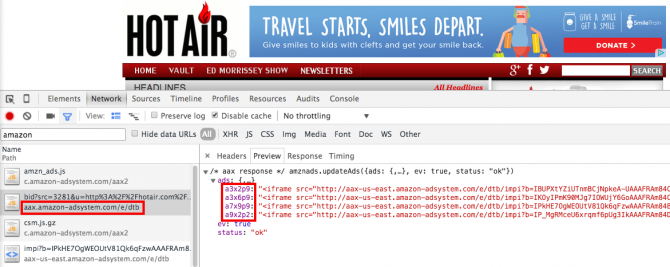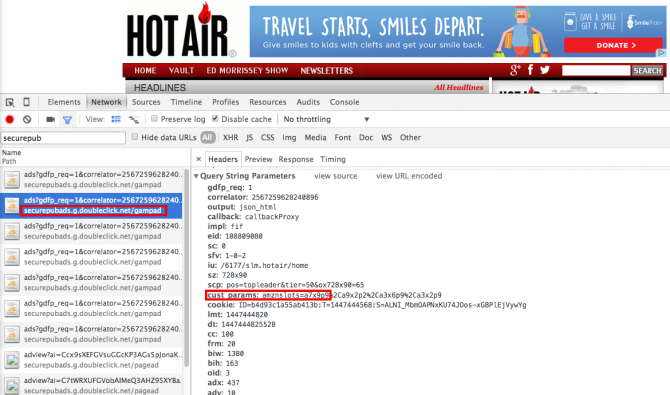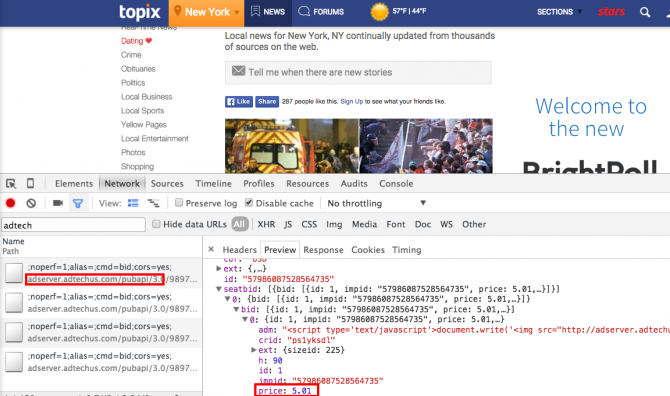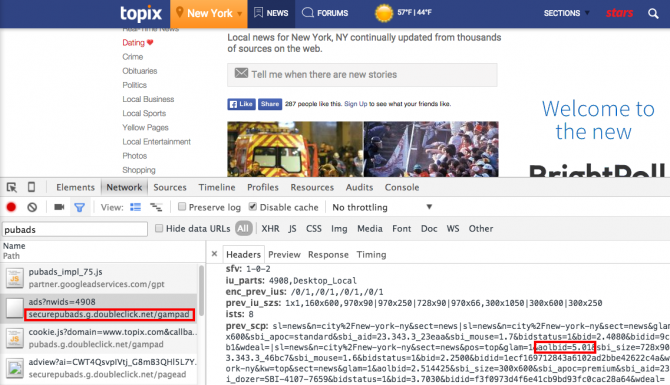My original header bidding articles have been read by over 10,000 people since I posted them in late June of this year, and one of the most common questions I got in the comments and on other channels was where to see a header bidding integration live on a real publisher. At the time, there wasn’t much press on the topic, but in the past months AdExchanger, Digiday, BusinessInsider, and many other sites have posted articles, and publishers have come out to talk about their experience with the technology. So now, there are lots of examples to look at to get a better understanding of what a header bidding call actually looks like, what information it returns, and how the header bid gets into the publisher ad server.
Fortunately, using the built in developer tools in either Chrome or Firefox, we can easily see if a given publisher is using header bidding technology by searching for ad tech domains and explore the details from each call. All we need to do is check the header bidding response and the ad server request code to see what variables are passed as custom key-values (the custom_params variable specifically in DFP), which will tell us what partners are in place. You can even see how much marketers are willing to pay for your ad space. I was able to find an example integration for every header bidding integration available on the market today by looking at the sites who were quoted in press articles (specific sources are listed at the end of this post), and screenshot both the response code from the header bidder as well as the matching parameter in the call to the ad server. Hopefully this helps everyone understand more tactically how header bidding actually works, and what to expect if you implement this technology for your own site.
Amazon A9
Example Publisher: HotAir.com
Domain: http://aax.amazon-adsystem.com/
Keyvalue: amznslots
From what I can tell, Amazon is by far the most common header bidding implementation. It’s often the first one publishers seem to do, and it makes sense given Amazon offers a large amount of high value retargeting demand and is very picky where they buy, preferring private exchanges.
Amazon also has some interesting nuances to their implementation – for one, they pass a variable that combines a number of pieces of information in a single value. The structure of the variable essentially describes either a display or mobile bid, a shorthand for the size being bid on, and an encoded price value. So, ‘a3x2p9’ can be broken down into three sections: ‘a’ is the code for an display bid; in some cases you’ll see an ‘m’ instead. ‘3×2’ is the shorthand for the 300×250 ad size, which in some cases is not abbreviated but written out long form. Naturally you can expect to see ‘7×9’, ‘3×6’, ‘1×6’, and other common IAB standard values here.
Additionally, ‘p9’ means ‘price tier 9’, which refers to a rate that Amazon and the publisher have agreed upon in advance and isn’t necessarily the same value from publisher to publisher. In other words, you can’t say that a p9 value on publisher A is worth the same as a p9 value on publisher B. In this way Amazon is the one header bidder that entirely obfuscates how they value a given impression. Other header bidders integrate to the ad server using an arbitrary value like Amazon, but the exact price they are willing to pay is typically accessible in the raw JSON response. Finally, Amazon tries to be very standardized in their implementation in that they always return the same number of bids on every page, even if the specific template doesn’t have an ad for every bid.
AOL
Example Publisher: Topix.com
Domain: http://adserver.adtechus.com/
Keyvalue: aolbid
AOL uses the same domain as their publisher ad server, ADTECH, for header bidding so it can sometimes be confusing to understand why the browser is making calls to that service, but the keyvalue gives it away, as well as the response from the call being a very neatly structured response that notes price, the creative tag, ad size, and more details.





Looks like that Sonobi one is based off The Matrix.
Rubicon is working on a specific actual value solution called project fast lane but it is doing so begrudgingly. Rubicon believes correctly (however, almost no publishers manager their stacks completely correctly to take advantage.) That the way to value an auction/ yield management is in terms of scarcity. Exact price doesn’t matter from this perspective of yield management. If they return a “yes” in a certain tier it means that impression is a high enough value and rare enough in Rubicon it should get priority unless AdX beats a specific floor. This methodology when done correctly distributes impressions to the highest possible value across the entire campaign.
Interesting color, Dave – thanks for the comment. I think I’d probably need more detail to really take an opinion on Rubicon’s described approach, although I’m not sure it makes sense at face value that exact price doesn’t matter as long as the relative price is higher. For one, I think that makes it pretty difficult to audit how good a job Rubicon’s system would do at calling higher / lower than AdX, and second, I think it makes log level data a lot more difficult to work with. That said, Rubicon has a smart team and I’m sure there’s more than meets the eye here – hopefully they’ll release more details on their unique take with header bidding.
For additionally clarity I forgot to add that their solution was designed to compete with a publisher’s direct/ guaranteed demand and allow for “price less auctions”, the idea being if direct is pacing, a scarce impression should serve. With that in mind, Rubicon actively promotes that if you use their header solution no other header tags should be allowed. The argument being fixed header bids like Criteo generally fill say 5-10% of impressions typically make the market (as the 2nd price) over 50% of the time in an auction environment and that long term fragmenting demand and turing exchanges into bidders will hurt CPMs. I agree in the case of fixed bidders like Criteo, but not for other similar exchanges to Rubicon.
Hello, is there any single one live and working implementation example of prebid.js?
Hi Alex,
Yes, Space.com has a working example – just open your developer tools and search for ‘prebid.js’ on the Network tab.
Hope that helps!
Ben
Ben, thanks a lot!
Things got definitely way more clear now.
Alex: Yes, we use Prebid.js as the framework for our PulsePoint Headder bidding wrapper, and are live with many of our publishers